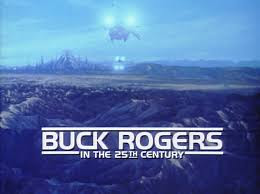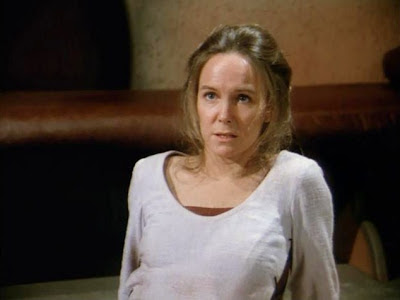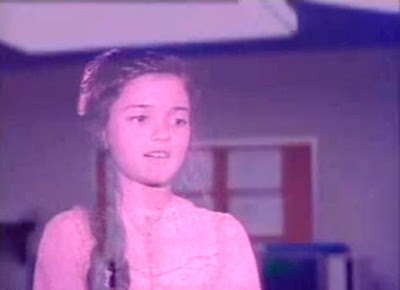"There are strange viruses here on this planet."
- Cyra (Anne E. Curry) warns Buck about the dangers of Arcanus in "The Satyr."
On first glance, however, this development seems unexpected since the episode's storyline stems from a long-standing and ubiquitous sci-fi TV trope: "the single mother in jeopardy."
In this all-too-familiar genre TV chestnut, a series protagonist encounters a lovely single mother and her child (usually a son) who are being menaced by some malevolent outside force. The series hero then becomes a stand-in husband/father to the duo, defeats the menace, and -- in a heartbreaking moment -- must say farewell to his new family so that he may continue his episodic adventures romantically unimpeded.
Examples of the "single mother in jeopardy" convention can be found on the original Battlestar Galactica (1978 - 1979) in "The Lost Warrior," where the convention is played well as a variation on Shane (1953) and as a commentary on gun control, in V: The Series as "The Wildcats" (wherein Marc Singer's Mike Donovan steps in to save a Mom and her daughter from the Visitors), and on MacGyver, "To Be a Man," which featured the late Persis Khambatta as Zia, the single mother in jeopardy from Russian military forces.
Examples of the "single mother in jeopardy" convention can be found on the original Battlestar Galactica (1978 - 1979) in "The Lost Warrior," where the convention is played well as a variation on Shane (1953) and as a commentary on gun control, in V: The Series as "The Wildcats" (wherein Marc Singer's Mike Donovan steps in to save a Mom and her daughter from the Visitors), and on MacGyver, "To Be a Man," which featured the late Persis Khambatta as Zia, the single mother in jeopardy from Russian military forces.
In Buck Rogers': "The Satyr," Captain Buck Rogers (Gil Gerard) explores the planet Arcanus, the site of a failed Earth colony while the star ship Searcher is away for ten days on a mission to "sweep" an asteroid belt.
On the planet surface, Buck soon meets Cyra (Anne E. Curry) and her son, Delph (Bobby Lane), the only two settlers who have remained behind on the planet. Buck soon discovers that the duo is regularly harassed by Pangor (Dave Cass), a half-man/half-goat or "satyr" who seems obsessed with them. Buck steps in to battle the violent Pangor, but is bitten by the satyr.
Over a period of days, Buck begins to transform into a satyr himself, a creature obsessed with women and wine...and little else.
After being bitten, Buck learns that Pangor is actually Jason Samos, the founder of the Arcanus colony and Cyra's much-mourned husband. She has been unable to leave the planet behind because she still feels attached to him, despite Jason's transformation into a rampaging monster.
On the planet surface, Buck soon meets Cyra (Anne E. Curry) and her son, Delph (Bobby Lane), the only two settlers who have remained behind on the planet. Buck soon discovers that the duo is regularly harassed by Pangor (Dave Cass), a half-man/half-goat or "satyr" who seems obsessed with them. Buck steps in to battle the violent Pangor, but is bitten by the satyr.
After being bitten, Buck learns that Pangor is actually Jason Samos, the founder of the Arcanus colony and Cyra's much-mourned husband. She has been unable to leave the planet behind because she still feels attached to him, despite Jason's transformation into a rampaging monster.
As I've noted above, the "single mother in jeopardy" cliche has been depicted on television many times, but "The Satyr" illustrates nicely how a science fiction program can explore contemporary issues that "regular" dramatic programs either cannot, or if they do seems too on the nose, like an Afterschool Special.
Clearly, this episode of the series sub textually concerns alcoholism; and the effect of alcoholism upon the entire family unit. This subtext and social commentary actually elevates "The Satyr" above its familiar and cliched premise and makes it one of Buck Rogers' finest hours.
Clearly, this episode of the series sub textually concerns alcoholism; and the effect of alcoholism upon the entire family unit. This subtext and social commentary actually elevates "The Satyr" above its familiar and cliched premise and makes it one of Buck Rogers' finest hours.
In "The Satyr," Cyra and Delph live a relatively happy life, until Dad -- Pangor -- shows up at their home, demanding wine and violently threatening Mom.
In one well-staged scene, we watch with Delph through an exterior window as, inside the home, Pangor pushes Cyra onto her back (behind the kitchen table), and threatens physical violence. He wants more wine, you see, even though, as Cyra tells him, "he drank it all the last time." The subtext here isn't just violence, but sexual violence, at least in terms of the staging/blocking.
What we get in "The Satyr," particularly in this camera view from the outside-in, is the notion of a child dwelling in a terrifying household of alcoholism and domestic violence, and seeing/experiencing things that no child should. Worse, the P.O.V. suggests isolation and helplessness.At several points during the episode, Delph is also policed by his mother not to be too conspicuous, so as not to gain the attention of the alcoholic/Satyr. At one point, Delph plays "flute grass" and at another point he calls out innocently for his Mom. In both instances he is quickly "hushed" -- "Don't shout!" -- lest the angry man of the household focus his violent attention upon him. Half the battle is staying off Pangor's radar as he pursues his vices.
Additionally, the boy, Delph, soon sees himself as his mother's defender, eventually fighting the angry Pangor and telling the beast to "leave my mother alone." In the homes of many alcoholics, it is indeed the child who eventually becomes the protector of the Mom,or other siblings, and who stands-up to the offending drinker.
As for Cyra, she's dramatized in this episode as the traumatized, exhausted victim of sustained domestic abuse. She hides bruises on her neck from Buck, and, quite understandably, doesn't like "to be touched."
She also has much trouble letting go of the "good man" who was once her husband, clinging to old photo albums which reveal happier, more romantic days. Much of the blocking depicts Cyra cowering or retreating. She is someone who is used to being terrorized and fears being struck.
Cyra also maintains the family home on Arcanus -- despite the danger to herself and her son -- in the misguided belief that somehow Pangor can change. In fact, Cyra spends her life appeasing the violent satyr. "If he's supplied with enough [wine]," she informs Buck, "he's content" and leaves the family alone.
At the same time that she must handle Pangor, Cyra worries that the "virus" that affected her husband -- a metaphor for alcoholism -- could affect her son too "when he's a man." In other words, the cycle of abuse and violence could continue to the next generation. Yet by keeping Delph on Arcanus, in a terrorized home, Cyra makes it more likely that this will happen to Delph.
This social commentary in "The Satyr" is intriguing by itself, but the episode gains some real unexpected juice and power when Buck actually grows sick with "the virus "and quickly loses his status as the white knight.
Buck sets up house with Cyra and Delph (even teaching the boy to fly his shuttle craft) and then -- just when things are good -- succumbs to the same "virus' and begins to show signs of physical violence like Cyra's previous husband. In one sequence, Buck tries to hide evidence of his transformation from Delph, ashamed to show his true nature as a "monster" to the boy he clearly cherishes.
Here, the subtext isn't about alcoholism so much as the nature of (some) men in general, and how some women seem to attract these monsters, one after the other. It's something in their individual nature and lack of self-esteem perhaps, and part of a deadly symbiosis involving abuser and victim. '
"The Satyr" tries to make viewers understand why Cyra stays on Arcanus, imperiled by one satyr after the other, and gives us some insight into the mentality of a perpetual victim. In this case, Cyra just can't let go of the past and the (vain) dream that Pangor could again become the husband she once loved.
Of course, Buck -- as our stalwart series hero -- is able to kick the virus and save the day. Still, it was pretty daring in terms of 1981-era television to create a metaphor for alcoholism and then see the likable series protagonist succumb to that "disease." In visual terms, Buck's horns literally start to come out, as he transforms from man to beast.
I am old enough to remember the promotional materials and interviews for the second season of Buck Rogers in the 25th Century. The overall promise by the producers was that Buck would become more recognizably and fallibly human, and less the quipping, boogeying, Burt Reynolds-in-space figure of the first season.
Whether or not that promise was fulfilled entirely is up for debate, but certainly "The Satyr" showcases Buck at his most human and interesting. He exhibits real remorse when he believes he is responsible for the death of Cyra's husband, Jason, and then must battle his growing "dark side" as the satyr virus takes hold.
This episode is also intriguing for the way it ties the myth of the Satyr (a wine loving man/goat) to the alcoholism/domestic violence symbolism, and for the implicit "reason" behind alcoholism provided by the show.
Jason had the "pioneer spirit," you see, and had hoped to turn Arcanus into a "garden of Eden." When that dream failed, he couldn't handle it...and that's when he first acquired "the virus." Again, this idea fits our contemporary world well.
What leads people to drink? Failure? Tragedy? Loss? Desperation?
Like the best social commentary in science fiction television (from The Twilight Zone to Star Trek to The X-Files to Buffy), this is an episode that plays ably on two levels. You can watch it just as a gripping, good adventure, or as a story with a bit more relevance and meaning in our own world.
In other words, the metaphor for alcoholism holds powerfully (right down to the blocking of the actors), but you aren't hit over the head with a "lesson."
At the very least, "The Satyr" adds some much-needed depth to an old TV trope. In this Buck Rogers episode, the single mother was again in dire jeopardy, but it's the nature of that jeopardy and the source of the jeopardy that make this installment meaningful and unique, even after four decades.




















































